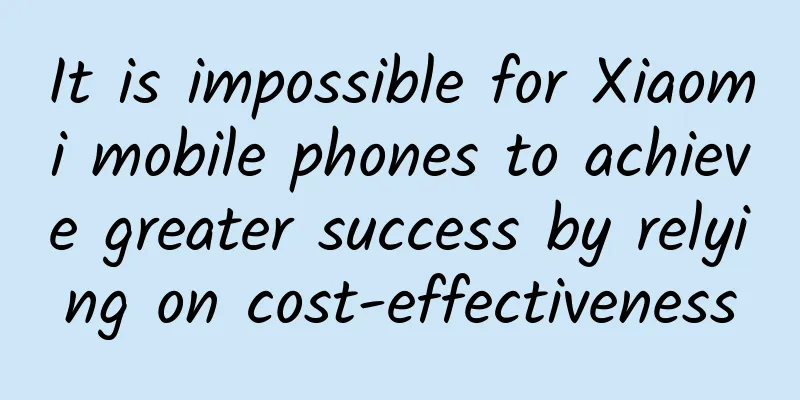It is impossible for Xiaomi mobile phones to achieve greater success by relying on cost-effectiveness

|
When Xiaomi was first founded, "enthusiastic" and "cost-effective" became important market labels and user appeal for Xiaomi phones. "Fever" means high configuration, and "cost-effective" means low price compared with competing products. However, with the large-scale expansion of Xiaomi's offline channels, the sharp increase in marketing expenses, and the acceleration of overseas expansion, Xiaomi has reached a stage where it should put aside the label of "cost-effective". Behind the cross-selling and price gouging in offline channels According to the "China's October 2017 Cross-selling Tight Mobile Phone Market Analysis Report" recently released by the First Mobile World Research Institute, Samsung W2016, Xiaomi Note 3, and Samsung G9350 are the top three "cross-selling" mobile phones in the domestic offline mobile phone market. Cross-selling of mobile phones means that dealers no longer purchase goods from Xiaomi's official channels, but choose third-party channels with lower prices, which will also lead to "random pricing" in different regions and channels. As we all know, Samsung's mobile phone channel management in the Chinese market is chaotic, with "mixed goods", "random prices", "out-of-control price guarantees" and "overpricing", which has led to its near "collapse" in the third-tier and below channel market in China. Xiaomi mobile phones only started to accelerate the expansion of offline channels in 2017, so it is very necessary to learn from Samsung's lessons. The First Mobile Phone Industry Research Institute said in its report that "after the National Day, Xiaomi announced to offline channels through WeChat and phone calls that it would stop selling Xiaomi Note 3 until the market price improves and the offline channel inventory returns to normal." As for the cause of the problem, the First Mobile Phone Industry Research Institute said that it learned through offline channels in Henan Province that "the Xiaomi Note 3 is priced too high and has a low cost-effectiveness. In addition, the offline channels have too much goods, which has led to inverted prices in offline channels and various forms of dumping." Xiaomi Mi Note 3 is a new flagship Note series product released by Xiaomi on September 11 this year, priced from 2,499 yuan. However, according to Xiaomi's previous product series, Xiaomi Mi Note is a higher-end product than the Xiaomi digital series of the same period. However, in terms of configuration, it is not only significantly lower than Xiaomi 6, which uses Qualcomm Snapdragon 835 processor and UFS storage, but also breaks the tradition of Xiaomi Note series that it has always used Qualcomm's latest flagship processor. Even its screen has been changed from Samsung OLED curved screen of Xiaomi Note 2 to 1080P 5.5-inch screen. Perhaps this is why the First Mobile Phone Industry Research Institute believes that it is "priced too high and the product cost performance is low". In fact, judging from the products released by Xiaomi this year, except for the Xiaomi Note 3, the Xiaomi 5X and Redmi Note 5A have obviously shown similar "reduction in configuration". The important reason behind this is that in order to cooperate with Xiaomi's channel strategy adjustment to focus on the third-tier and below offline markets, sufficient profit space must be left for channel dealers. However, Xiaomi's past labels of "hot" and "cost-effective", as well as the inherent impression it has created for users, are hindering the sales of Xiaomi's new offline products in the channel. Once the product scale is overstocked, the higher the profit left to the channel dealers, the more serious the "random pricing" and "mixed goods" will be. Without a "price guarantee" strategy, it will be enough to create a channel "disaster" for mobile phone companies. Marketing costs have risen sharply When Xiaomi was first established, it was proud of its marketing strategies such as "user participation", "zero advertising", and "no brand spokesperson". From 2011 to 2014, Xiaomi did enjoy the full benefits of Internet word-of-mouth communication with the rise of social platforms such as Weibo. However, as other mobile phone companies have gradually learned Xiaomi's "play style", the online communication methods and user "sense of participation" of the press conferences of various mobile phone companies have become more and more similar, and the dividends of Internet word-of-mouth communication are rapidly being diluted. While expanding its offline channels, Xiaomi also began to learn from OPPO and vivo, starting large-scale advertising, celebrity endorsements, and even spending huge amounts of money to compete with OV for popular variety shows. Xiaomi invited Wu Xiubo, Liu Shishi and Liu Haoran to be brand ambassadors for the Redmi Pro released in July 2016. In October 2016, Xiaomi signed Tony Leung to endorse the Xiaomi Note 2. In September 2017, Xiaomi announced that Wu Yifan would endorse the Xiaomi Note 3. In the popular variety shows, Xiaomi first spent 140 million yuan to become the title sponsor of the fourth season of "U Can U Bibi", and then sponsored popular variety shows such as "The Rap of China" and "Our Couple Travel". On September 6, 2017, Lei Jun posted a photo of Xiaomi MIX2 large outdoor billboards in nine major cities on Weibo. In addition to the traditional orange VI, the same advertising space has also seen the shadow of OV... ... From "0 advertising" and "no brand spokesperson" to learning from OV, Xiaomi has made the inevitable choice to increase its brand premium and enhance its marketing synergy with offline channels. However, whether it is "screening" landmark buildings in various cities, inviting many prominent spokespersons, or sponsoring advertisements for popular variety shows for hundreds of millions of yuan, these costs will be allocated to the price of Xiaomi mobile phones. Expanding overseas markets and patent risks In July 2014, Xiaomi launched its first smartphone, Xiaomi 3, in India. At that time, only a small auditorium was chosen and not many media participated. From the second half of 2015 to the beginning of 2016, due to supply chain reasons, the fingerprint recognition feature of Redmi Note 3 was launched too late, and the launch of several subsequent products was delayed, resulting in a backlog of products in the domestic market of Xiaomi. However, this objectively promoted the expansion of Xiaomi mobile phones into emerging overseas markets such as India. India's average income is about one-fifth of China's, and the country is very sensitive to the price of electronic products. The best-selling smartphones in the market are all priced at $100. Relying on the Redmi series, which has experienced fierce competition in China's thousand-yuan phone market, Xiaomi has grown rapidly in the Indian market with a "cost-effective" strategy, which is very similar to its rise in the Chinese market in 2011. Take the best-selling Redmi 4A as an example. Its price is 5999 rubles, equivalent to 610 yuan (92 US dollars). When Redmi 4A was first released, it even set a sales record in the Indian mobile phone market, selling 250,000 units in 4 minutes. According to the IDC report, in the second quarter of 2017, the shipment volume of Redmi Note 4 exceeded 2 million units, becoming the most shipped smartphone in a single quarter in the history of the Indian smartphone market. Lei Jun revealed in an internal letter in July this year that Xiaomi's performance in India in the first half of 2017 increased by 328% year-on-year, and its market share ranked second only to Samsung. However, Xiaomi's expansion into overseas markets is not without its concerns. The biggest one is patents, and the other is whether it can make a profit. In December 2014, when Xiaomi was expanding into the Indian market, it was sued by Ericsson for "suspected infringement of Ericsson's eight patents" and was almost banned from sales. Later, an Indian court granted Xiaomi a temporary license - on the premise of prepaying 100 Indian rupees per device and depositing it with the court, Xiaomi can continue to sell Qualcomm chip phones in the Indian market, but phones with MediaTek and Spreadtrum chips are banned from sale. As Xiaomi becomes the second largest mobile phone brand in India, the possibility of it being targeted by international patent companies is very high. You should know that in the era of feature phones, a Chinese mobile phone company G`FIVE once occupied 21% of the Indian mobile phone market in 2011, which is higher than Xiaomi's current share. However, Nokia immediately filed a lawsuit in India for alleged intellectual property infringement. In the end, G`FIVE chose to withdraw from the Indian market and move to Africa. In fact, Xiaomi has also responded to patent issues in recent years, such as announcing this year that it has signed a business cooperation agreement and a multi-year patent license agreement with Nokia. It has introduced Indian business giant Tata to invest in Xiaomi, actively responded to the "Make in India" national strategy promoted by Indian Prime Minister Modi after taking office, and officially put its second factory in India into operation, announcing that 95% of smartphones sold in India are locally manufactured, etc. All Chinese mobile phone companies investing in India are facing a similar problem: almost no one can make a profit. The difficulty of paying for mobile Internet services in India, where the low-income population has a long history, will further exacerbate Xiaomi's profitability problems in the country. As Xiaomi expands into other markets, such as Spain and other developed markets, its patent risks will increase dramatically. It should be noted that after solving the Nokia case, there is also Ericsson, a European communications giant that is currently in court, and a large number of small and medium-sized patent companies. Therefore, whether Xiaomi chooses to increase investment in overseas markets or purchase patents/pay patent fees from international giants, it will be included in the price of Xiaomi mobile phones. And as its overseas shipments increase, the costs and patent risks it faces will continue to increase. No consumer electronics company can succeed by relying on “price/performance” When talking about Xiaomi's development model, Lei Jun compared it with many companies including Apple, Sony, Amazon, and Costco. However, Costco, which is most highly praised by Lei Jun, does not produce electronic consumer products and does not face huge technology investment and patent risks. Therefore, it can control gross profit margin by strictly selecting brand products that have no competition with itself, and can sell annual membership cards for US$100 to US$120. At the same time, there has never been a company in the global electronic consumer goods sector that has ultimately achieved market success by relying on “cost-effectiveness”. This is certainly not the case with Apple, Sony, and Amazon, nor with Gree, China’s largest air-conditioning giant that was mocked by Xiaomi. Even Chinese mobile phone companies that Xiaomi dissed about “cost-effectiveness”, such as Dakele, ZUK, LeTV, and 360, have either disappeared or given up the “cost-effectiveness” strategy. From this perspective, labels such as "price-performance ratio" and "enthusiastic" that once helped Xiaomi open up differentiated markets have now become constraints on its expansion into offline markets, enhancement of brand premium, and even affecting its expansion in technology and overseas markets. Today's Chinese mobile phone market is completely different from that in 2011. Today's Xiaomi is no longer the young man it once was. It's time to put aside the label of "value for money". As a winner of Toutiao's Qingyun Plan and Baijiahao's Bai+ Plan, the 2019 Baidu Digital Author of the Year, the Baijiahao's Most Popular Author in the Technology Field, the 2019 Sogou Technology and Culture Author, and the 2021 Baijiahao Quarterly Influential Creator, he has won many awards, including the 2013 Sohu Best Industry Media Person, the 2015 China New Media Entrepreneurship Competition Beijing Third Place, the 2015 Guangmang Experience Award, the 2015 China New Media Entrepreneurship Competition Finals Third Place, and the 2018 Baidu Dynamic Annual Powerful Celebrity. |
>>: Can't afford the $10,000 "autopilot" function? Musk said: You can rent it monthly
Recommend
Haoze talks about the truth about ordinary people's wealth 1 document Baidu cloud download
Haoze Yitan·The truth about ordinary people's...
Review of the new toy for geeks: Baofeng Magic Mirror 3 plus
At this year's E3 exhibition, Microsoft's...
Learn these 6 ways to play, and your Douyin account can also bring goods
As Douyin’s ability to sell goods continues to im...
Wang Zheng's "Gestalt Psychotherapy" 60 lessons, from entry to mastery
Training course video content introduction: This ...
How to make Kuaishou’s live streaming GMV exceed 10 million?
In 3 months, the number of simultaneous online us...
Where is the most beautiful karst in China?
In China There is a kind of landscape It not only...
【Responsive website development】Achieve multi-terminal compatibility at a low cost
Chapter 1: Course Introduction 1.1: Talking about...
How Much Do You Know About Spring Flowers? - A Guide to Viewing Spring Flowers of the Rosaceae Family (Part 2)
Produced by: Science Popularization China Author:...
Cui Yong: Why is China's "Nanhai I" called an unprecedented model of underwater archaeology?
The excavation of "Nanhai I" was more d...
What is the price for Nanping Furniture Mini Program investment? Nanping furniture mini program investment price inquiry
How much does it cost to attract investment throu...
It is flammable and explosive, and you may wear it every day
Not long ago, a netizen uploaded a video of "...
Wu Jingtao, Vice President of Tingyun Technology: The giant ship of APM and operation and maintenance will not sink
With the development of the information age, mobi...
A man died after extracting 23 teeth at once! Can you only extract one tooth at a time?
When it comes to tooth extraction, everyone is fa...
How can a novice quickly get started writing promotional copy?
01. How can a novice quickly get started in writi...






![Bao Juncheng: [ATA Full Literacy] High-end Literature Series (A)](/upload/images/67cc0da6c4ebb.webp)


